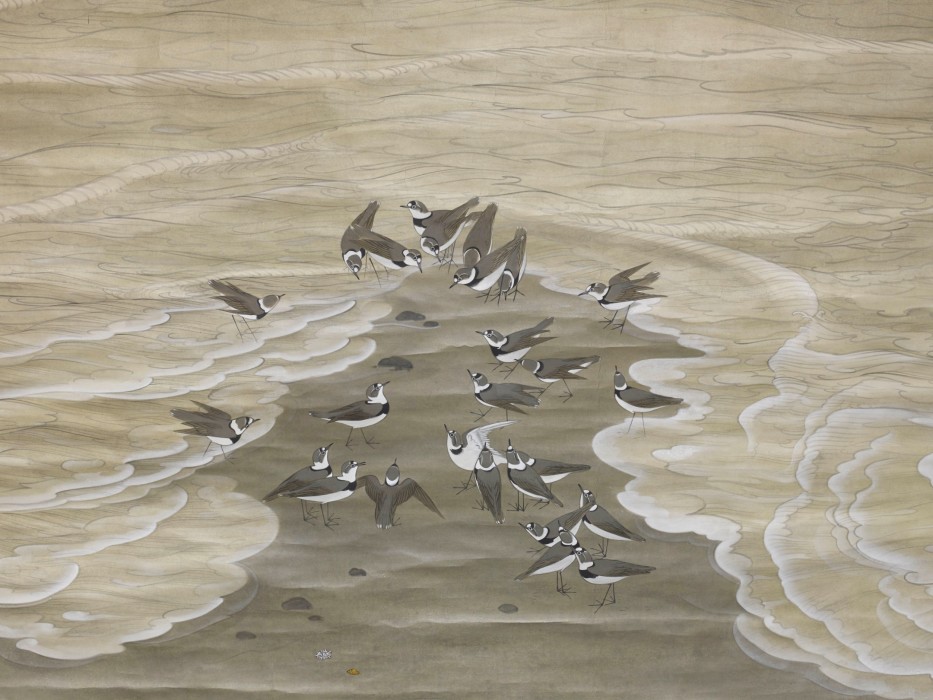Product Description
6593 A paper kakemono (hanging scroll) printed with fuki (butterbur) leaves and painted with a katatsumuri (snail). The border painted with stylised snow-flakes and flowers.
Signature: Jōan
Seal: Watanabe-no-in (the seal of Watanabe)
Seal: Jōan
Inscribed: Samidare no ame shiranu kao ni katatsumuri, tsuno ukokashite hai nohoru miyu. (Fifth month rain, not caring about the rain at all, a snail, moving its antennae about, I can see it climbing up (the butterbur stalk)).
Seal: Sonyū
Signature on the mount: Nanaju hachi o Koho ga (painted by Koho at the age of seventy eight) with kao (cursive monogram)
Japan 20th century Shōwa period
Dimensions:
Scroll: H. 84¾” x W. 15¾” (215cm x 39.5cm)
Painting: H. 51¾” x W. 11½” (131cm x 29cm)
Snail painted by Watanabe Jōan
Inscription by Umekami Sonyū
Mount painted by Ueda Kōho
Tomobako lid:
Top: Akita-fuki oshigata (Butterbur of the Akita region, stencil/ stamp painting)
Inside: San Umekami Sonyū-shi, kagyū (katatsumuri) Watanabe Jōan hitsu, byō-hyōgu sekka-moyō Kōho-ga heidai-su.” (Inscription written by Priest Umekami Sonyū, painting of a snail by Watanabe Jōan, the hanging-scroll-mount decorated with snowflakes design painted by (Ueda) Kōho). Seal: Kōho
Watanabe Jōan (active 1958). An accomplished painter, calligrapher and Tea master of the Yabunouchi School of Tea. He was also known for making tea utensils and was the author of an article titled Chaseki meguri 5: Yabunouchi soke en’an, (Introduction to tea houses, number 5: the Yabunouchi School of Tea; the Tea-house “The Swallow Room”), published by the Nihon Bijutsu Kogei-sha (Japan Art Crafts Company), in 1958
Umekami Sonyū (1882-1945). Gō (art name): Saian. Born in Kyoto, the son of Myōjo Ōtani Kōson (1850-1903), the 21st abbot of the Nishi-Honganji Pure Land sect, Kyoto. Both Umekami and his elder brother Ōtani Shinsai Sonyū (1886-1939), became priests of the same sect. Umekami Sonyū was a skilled painter and tea ceremony practitioner who made bamboo tea scoops and pottery for Tea. He studied tea ceremony under Yabunouchi Tōgetsusai (1865-1942), also known as Chikusō Shōchi, the 11th master of the Yabunouchi School of Tea. In later life he became Vice President of Kanto-kai and a member of Hōan-kan, Jōan-kai, and Takuryū-kai, members’ only Tea practitioner groups.
Ueda Kōho (1860-1944) born in Osaka. He was the third generation of the distinguished Ueda painting family specialising in Maruyama and Nanga school painting. His grandfather was Ueda Kōfu (1758-1831) and his father was Ueda Kōchū. (1819-1911). The family had a cultural connection with the Sumitomo family (Zaibatsu, Osaka), great patrons of Art and culture.






